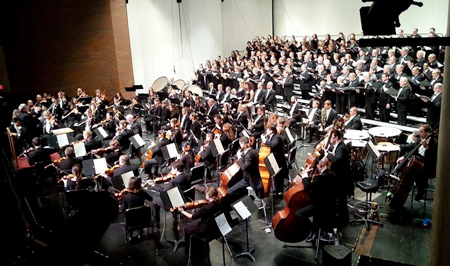by Tom Wachunas

The evening began on a decidedly funereal note with the Leopold Stokowski transcription of Henry Purcell’s Dido’s Lament. Purcell’s 1688 chamber opera, Dido and Aeneas, was based on Book IV of Virgil’s Aeneid, and tells of Dido, Queen of Carthage, her love for the Trojan hero Aeneas, and her suicidal despair when he abandons her to return to Italy. Dido’s Lament was named for the story’s final aria, among the most arresting moments in all of opera: “When I am laid in earth, may my wrongs create no trouble in thy breast. Remember me, but ah, forget my fate.”
Stokowski once offered this observation to fellow conductors: “We have to try to understand and give to the listening public what we consider was in the mind of the composer.” Assistant Conductor Matthew Jenkins Jaroszewicz clearly took that sage advice to heart. He let Stokowski’s sublime arrangement for lush-sounding strings do all the singing and directed his attentive ensemble through slowly unfolding, nuanced layers of the bittersweet melody, beautifully augmented by poignant solos from principal cellist Brian Klickman.
One might reasonably hope that after experiencing the searing emotionality of the lament, the next program selection would offer something less morose, more uplifting, or at least gracefully optimistic. Instead, Igor Stravinsky’s suite of eight pieces from his music for the ballet, Pulcinella, was an oddly frenetic interlude in this context. After drinking so deeply of Dido’s pathos, Pulcinella, even in its most pleasant moments, had all the grace of a hiccup. The fault, if it could be called one, was neither in the orchestra’s adventurous performance nor in the brisk conducting by Jaroszewicz.
In 1920, Stravinsky was so impassioned by his study of the charming simplicity he encountered in assorted choral and instrumental scores by 18th-century Italian composer Giovanni Pergolesi (and a handful of other forgotten composers) that he reworked them for his ballet score. If the music sounds like a somewhat scatterbrained exercise in thematic meandering, it’s only because it reflects the dual nature of Pulcinella himself. He was a comic hero who became a stock character in 17th-century Neapolitan commedia dell’arte productions. Depending on a given scenario, he could be a crass, silly bumpkin, or a proud, witty thief, and often both.
As it was, the orchestra pranced through all the suite’s spasmodic twists of harmonies, textures, and rhythms in a spirit of giddy abandon. Fortunately, the intermission afforded enough distance from such worldly wanderings so we could more calmly prepare for passage into loftier realms. After all, we were about to be taken to church.
Responding to a complaint that the ending of one of his Masses was too frolicsome, Franz Joseph Haydn said, “I cannot write them otherwise. When I think of God, my heart is so full of joy that the notes gush forth as from a fountain. Since God has given me a joyful heart, He will forgive me for having served Him joyfully.” Haydn composed Missa in Tempore Belli (Mass in Time of War) in the autumn of 1796, a notably unjoyful time. France and Austria were at war, and Napoleon’s army was advancing toward Vienna.
Under the commanding baton of Canton Symphony chorus director Britt Cooper, singers and orchestra delivered a reverent, brilliantly-paced account of this dramatic work that was wholly magnificent. Cooper’s meticulous sensitivity to the ebb and flow of expressive dynamics in the work — when to be loud, when to be soft — was impeccable. The vocal quartet, featuring the crystalline luster of soprano Heather Phillips, the steady warmth of mezzo-soprano Sandra Ross, the radiance of tenor Tim Culver, and the robust sonority of baritone Michael Roemer, was spellbinding. Additionally, the large chorus was itself a phenomenon of astonishing clarity and power, and always in perfect balance with the orchestra.
While Haydn effectively implied some of the wartime angst of his day in the Agnus Dei, the stunning music eventually soars above the morbid. Yes, it began with the chorus voicing an urgent, somber plea for mercy amid the encroaching sounds of timpani sounding out an ominous march. But bright trumpet fanfares signalled hope, and the chorus began to voice divine assurance in a dance-like rhythm, repeating dona nobis pacem, Haydn’s notes gushing forth as from a fountain. In the end, not only God, but we too, had been served joyfully.
Published on ClevelandClassical.com March 28, 2019.
Click here for a printable copy of this article



